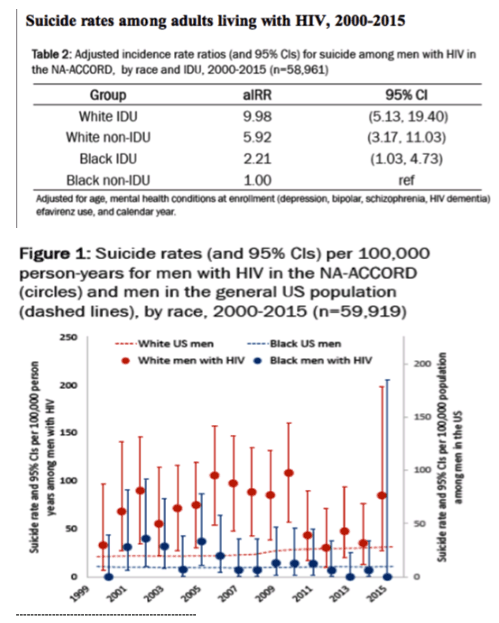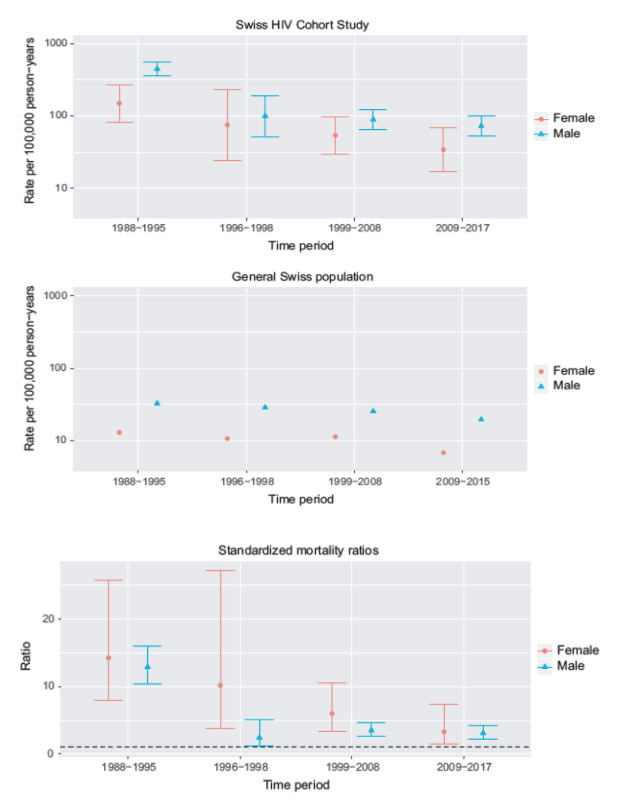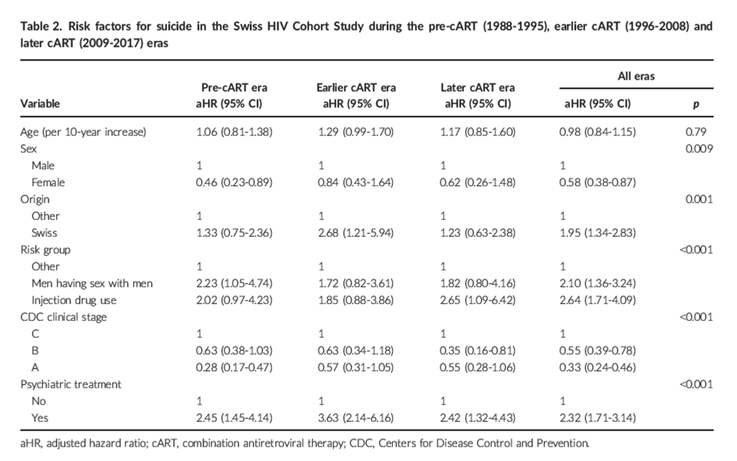| |
Mortality from suicide among people living with HIV and the general Swiss population: 1988-2017..... three times higher than in the general population
|
| |
| |
Download the PDF here
Factors associated with death due to suicide included gender (adjusted hazard ratio 0.58 (95% CI 0.38-0.87) comparing women with men), nationality (1.95 (95% CI 1.34-2.83) comparing Swiss with other), Centers for Disease Control and Prevention clinical stage (0.33 (95% CI 0.24-0.46) comparing stage A with C), transmission group (2.64 (95% CI 1.71-4.09) for injection drug use and 2.10 (95% CI 1.36-3.24) for sex between men compared to other), and mental health (2.32 (95% CI 1.71-3.14) for a history of psychiatric treatment vs. no history). There was no association with age.
Conclusions
Suicide rates have decreased substantially among people living with HIV in the last three decades but have remained about three times higher than in the general population since the introduction of cART. Continued emphasis on suicide prevention among men and women living with HIV is important.
------------------------------------
CROI-2019: Yearly suicide rate in white men with HIV usually far exceeds rate in US population....http://www.natap.org/2019/CROI/croi_34.htm
CROI-2019: Suicide rates among adults living with HIV, 2000-2015......http://www.natap.org/2019/CROI/croi_151.htm
--------------------------------------------------

Mortality from suicide among people living with HIV and the general Swiss population: 1988-2017
18 August 2019
We found that living alone was associated with higher suicide rates (aHR 1.83, 95% CI 1.17-2.87) during 2002-2017, independently of the other factors. Sexual orientation, substance use and other mental health problems may be distal common causes of HIV infection and suicide, with HIV-related stigma, addiction, and depression on the proximal causal pathway to suicide 2. Meta-analysis of cross-sectional studies of lifetime suicide attempts showed that the risk was higher in lesbian, gay and bisexual people than heterosexual people, and particularly high in gay and bisexual men 24. A Danish study 25, but not a study from the United States of America 26, showed that mortality from suicide was higher in MSM than in heterosexual men. In a French survey, poor socio-economic status was shown to be associated with an increased risk of suicide attempts in women with HIV 27, while loneliness and discrimination were also associated with a higher risk of suicide, independently of sex and sexual orientation 28. How do suicide rates in people with HIV compare with those suffering from other conditions? Suicide rates have been shown to be higher in people with conditions associated with chronic pain or poor prognosis 29, including patients with cancer 30, neurological diseases such as amyotrophic lateral sclerosis 31 or progressive multiple sclerosis 32. An analysis of the Surveillance, Epidemiology and End Results database 1973 to 2013 in the United States of America showed that SMRs for suicide ranged from 1.18 for prostate cancer to 4.17 for lung cancer 33. SMRs decreased over time for all cancers, but particularly for lung cancer. An increased risk of suicide has also been shown for several neurological disorders, including multiple sclerosis, stroke, Huntington disease and epilepsy, whereas Parkinson's disease may be associated with a reduced risk of suicide 34. Of note, in a nationwide sample of people with HIV on cART in the Netherlands, poor mental health was more common in people living with HIV compared to people living with diabetes or rheumatoid arthritis 35.
Conclusions
Since the introduction of cART in 1996, mortality rates due to suicide have significantly decreased in men and women living with HIV in Switzerland, but no important improvements in SMRs were observed in men in more recent years, despite the advent of more tolerable, more efficacious and less complex antiretroviral drug regimens in the later cART period 17. Furthermore, it is noteworthy that the SMRs were larger than those reported in the literature for conditions with worse prognosis. In Switzerland and elsewhere, there is a continued need to monitor depression, suicidality in HIV-positive people, and to develop tailored suicide prevention programs aimed at reducing suicide risk in people living with HIV.
Abstract
Introduction
In many countries, mortality due to suicide is higher among people living with HIV than in the general population. We aimed to analyse trends in suicide mortality before and after the introduction of triple combination antiretroviral therapy (cART), and to identify risk factors associated with death from suicide in Switzerland.
Methods
We analysed data from the Swiss HIV Cohort Study from the pre-cART (1988-1995), earlier cART (1996-2008) and later cART (2009-2017) eras. We used multivariable Cox regression to assess risk factors for death due to suicide in the ART era and computed standardized mortality ratios (SMRs) to compare mortality rates due to suicide among persons living with HIV with the general population living in Switzerland, using data from the Swiss National Cohort.
Results and Discussion
We included 20,136 persons living with HIV, of whom 204 (1.0%) died by suicide.
In men, SMRs for suicide declined from 12.9 (95% CI 10.4-16.0) in the pre-cART era to 2.4 (95% CI 1.2-5.1) in the earlier cART and 3.1 (95% CI 2.3-4.3) in the later cART era.
In women, the corresponding ratios declined from 14.2 (95% CI 7.9-25.7) to 10.2 (3.8-27.1) and to 3.3 (95% CI 1.5-7.4).
Factors associated with death due to suicide included gender (adjusted hazard ratio 0.58 (95% CI 0.38-0.87) comparing women with men), nationality (1.95 (95% CI 1.34-2.83) comparing Swiss with other), Centers for Disease Control and Prevention clinical stage (0.33 (95% CI 0.24-0.46) comparing stage A with C), transmission group (2.64 (95% CI 1.71-4.09) for injection drug use and 2.10 (95% CI 1.36-3.24) for sex between men compared to other), and mental health (2.32 (95% CI 1.71-3.14) for a history of psychiatric treatment vs. no history). There was no association with age.
Conclusions
Suicide rates have decreased substantially among people living with HIV in the last three decades but have remained about three times higher than in the general population since the introduction of cART. Continued emphasis on suicide prevention among men and women living with HIV is important.
Figure 1. Suicide in the Swiss HIV Cohort Study and the general population, 1988-2017, by gender.
Rates in the cohort (upper panel), the general population (middle panel) and standardized mortality ratios (SMRs; bottom panel). Rates and SMRs with 95% confidence intervals are shown.


Trends in suicide rates in people living with HIV and the general population
Overall, 204 people with HIV died by suicide over 184,402 person-years, for a rate of 110.6 per 100,000 person-years (95% CI 96.4-126.9). Figure 1 shows trends in rates of suicide in comparison to the general Swiss population. In men living with HIV, crude suicide rates decreased from 446.1 per 100,000 person-years (95% CI 358.8-554.7) in the pre-cART era, to 99.1 (95% CI 51.6-190.5) in the two years following the introduction of cART, then to 72.4 (95% CI 55.3-96.4) in the later cART era. In women, the corresponding decline was from 148.9 (95% CI 82.5-268.9), to 74.9 (95% 24.2-232.3), then to 34.0 (95% CI 17.0-68.1). Crude rates also declined in the general Swiss population from the pre-cART era to the later cART era: from 32.6 (95% CI 32.1-33.2) to 19.5 (95% CI 19.0-20.1) in men, and from 12.9 (95% CI 12.6-13.2) to 6.8 (95% CI 6.5-7.1) in women. The SMRs comparing men living with HIV with men from the general population decreased from 12.9 (95% CI 10.4-16.0) in the pre-cART era, to 2.4 (95% CI 1.2-5.1) after the introduction of cART, after which it increased slightly to 3.1 (95% CI 2.3-4.3) in the later cART era. In women, the corresponding ratios declined from 14.2 (95% CI 7.9-25.7) to 10.2 (3.8-27.1), and to 3.3 (95% CI 1.5-7.4).
Risk factors for suicide in people living with HIV
Participants of the SHCS who died by suicide were more likely to be male, of Swiss origin, have a history of IDU and have a lower CD4 cell count at the last visit than patients who did not die by suicide. In the two cART eras, but not in the pre-cART era, those who died by suicide were also more likely to be in a more advanced clinical stage, and more likely to have been in psychiatric treatment (Table 1). Table 2 summarizes risk factors for suicide. All variables except age were important predictors of suicide over the entire study period. When analysed by period, psychiatric treatment was a strong predictor for suicide in all three eras, with HRs ranging from 2.41 to 3.67. Men and Swiss nationals had higher rates of suicide than women and other nationals, and patients with less advanced disease (stage A) had lower rates than those with more advanced disease, but these associations did not reach conventional levels of statistical significance for each ART era. When formally assessing trends across periods using interaction tests, there was little evidence that associations with risk factors changed (p values from interaction tests all > 0.1), in contrast to the previous analysis of the SHCS data up to the year 2008 10.
|
|
| |
| |
|
|
|